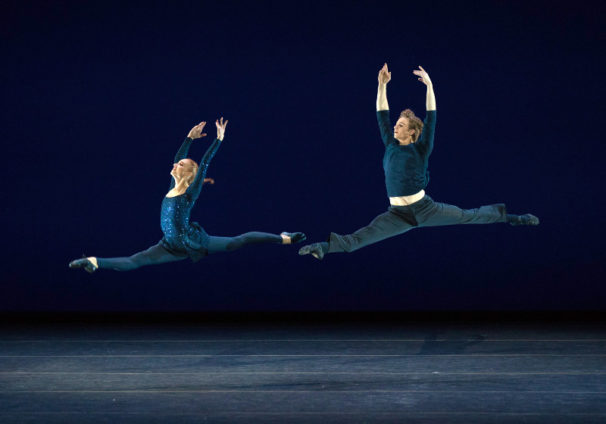
Twyla Tharp is back working with American Ballet Theatre. So for at least one evening — Wednesday’s much-anticipated premiere of her new ballet at the David Koch Theater — all seemed right with the world. Her prior work for the company dates to 2008; the ambitious and intriguing Rabbit and Rogue to a commissioned Danny Elfman score has not resurfaced since.
Unveiled at the opening gala of ABT’s two-week fall season, Tharp’s A Gathering of Ghosts celebrates Herman Cornejo, the exceptional principal dancer now marking his 20th anniversary with ABT. A longtime Tharp interpreter, Cornejo was Rabbit in Tharp’s previous ABT outing; has offered sensational performances in her Sinatra Suite and In the Upper Room; and was cast in one of the principal roles way back in 2000, when Tharp made Brahms-Haydn Variations for the company.

“Ghosts” is set to String Quintet No. 2 in G Major, Op. 111 by Brahms – a composer in whom Tharp has found prior inspiration having used this very score for a work for Pacific Northwest Ballet in 2008. Here, its four movements feature buoyant energy, invigorating rhythms, elegiac melodies, folk influences, and Tharp’s choreography feels refreshingly inevitable as it unfolds to this sublime music.
There’s a great deal to take in on first viewing of A Gathering of Ghosts. Norma Kamali, a longtime Tharp collaborator, has designed very individual and striking costumes for nine of the cast’s thirteen dancers (the remaining dancers, playing “Consorts” are dressed the same). While fascinating, the clothes at times distract. The palette is neutral – black, white, silver and a touch of beige – in styles ranging from lacy 18th-century to sleek athletic wear to elegantly shiny contemporary party outfits. They are mixed and matched with wild and humorous abandon.

Cornejo, wearing a sleeveless black jumpsuit with silver patterns, is identified as the Host, and it’s a diverse and scintillating centuries-spanning party that he’s hosting. His eight guests – or Ghosts, as the program identifies them – appear mainly in pairs, swirling and winding their way through the opening section with classical purity softened with a touch of sporty casualness. Cornejo holds center stage with his purity and aplomb, and his charismatic but modest presence. Tharp gives him plenty of opportunity to demonstrate his focused virtuosity, yet he comes across as relaxed.
Who is this thoughtful loner? And through what connections – or imagination – has he brought together these particular ghosts, drawn from both fiction and history, in assembling this party? One would have to match Tharp’s evident literary sophistication (which I definitely cannot) to analyze how and why these specific Ghosts came together. Calvin Royal, is North Wind – the central figure in a George MacDonald children’s fantasy-adventure. His well-matched partner, Christine Shevchenko, in a sleek filmy jumpsuit, is Irene – the name of the heroine of another MacDonald tale, The Princess and the Goblin, which Tharp turned into a 2012 ballet.

Blaine Hoven, as Louis XIV, wears a long gown not unlike that of his partner, Stephanie Williams. He partners her with muscular vigor, undistracted by the costume. Aran Bell, in glittery dark jacket and athletic shorts, is Mme. De Stael. His partner is Catherine Hurlin, whose energy and abandon fit her character, Greased Lightning. Proust (Wanyue Qiao) and Murasaki (Joo Won Ahn) are also in the mix, dancing together.
In the second movement, an Adagio, Cornejo is away from the party –- somewhere else, or perhaps in a different time period. He encounters four Consorts, all wearing sporty belted striped short dresses. He partners each in turn, but rather than potential romantic partners, they come across more as guides, sent to lead and teach the Host along his path. The choreography is spirited and vibrant, but once again Cornejo’s character seems isolated, in his own world.
He is absent from the third movement, which features Tharp’s inventive, fluent, and deliciously musical choreography for both Guests and Consorts. It’s worth noting that nearly all of these distinctive dancers performed in last spring’s terrific revival of Tharp’s 1973 Deuce Coupe, which, staged by Tharp herself along with Sara Rudner, triumphantly joined the ABT repertory.
The fourth movement assembles the full cast and gives ample opportunity for Cornejo’s technical wizardry in a sequence of seamlessly phrased multiple turns. Tharp allows his still-boyish playfulness to come through, but presents him as the mature master he has become.

The opening-night program also included Jessica Lang’s playful and show-offy duet, Let Me Sing Forevermore, to the music of Tony Bennett with the great man himself in the audience – a showcase for rising young soloists Catherine Hurlin and Aran Bell, possibly ABT’s current golden partnership; and George Balanchine’s Theme and Variations, a ballet that at ABT exudes more old-world glamor than does New York City Ballet’s blazing rendition.
American Ballet Theatre | Fall 2019 season | Lincoln Center | thru Oct 27
Susan Reiter covers dance for TDF Stages and contributes regularly to the Los Angeles Times, Playbill, Dance Australia and other publications.
